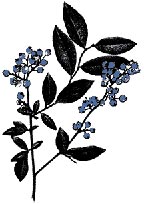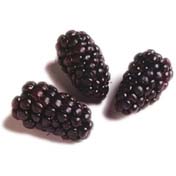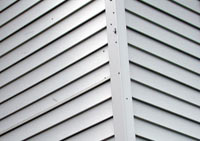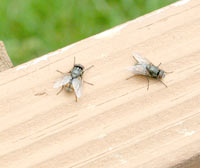Kentucky Pest News Newsletter
HIGHLIGHTS IN THIS ISSUE
Number 1040__________October 25, 2004
CORN
FRUIT
HOUSEHOLD
SHADE TREES AND ORNAMENTALS
DIAGNOSTIC LAB HIGHLIGHTS

CORN
NORTHERN CORN LEAF BLIGHT, PART II: SELECTING RESISTANT HYBRIDS
By Paul Vincelli
 In the previous issue of Kentucky Pest News, I wrote
about a potentially serious threat of Northern corn leaf
blight in 2005. To understand the potential risk, I'll
frame the situation in the disease triangle, the most
fundamental concept in plant pathology. What the
disease triangle tells us is that three components are
necessary for plant disease to develop: a causal agent
(such as a pathogenic microorganism) must interact with
a susceptible host plant in an environment that favors
disease development. Like a three-legged stool, it one
leg of this triangle is missing, the disease triangle "falls
down" and no disease develops. When all three are
present, disease develops. So consider the Northern leaf
blight (NLB) situation from that standpoint.
In the previous issue of Kentucky Pest News, I wrote
about a potentially serious threat of Northern corn leaf
blight in 2005. To understand the potential risk, I'll
frame the situation in the disease triangle, the most
fundamental concept in plant pathology. What the
disease triangle tells us is that three components are
necessary for plant disease to develop: a causal agent
(such as a pathogenic microorganism) must interact with
a susceptible host plant in an environment that favors
disease development. Like a three-legged stool, it one
leg of this triangle is missing, the disease triangle "falls
down" and no disease develops. When all three are
present, disease develops. So consider the Northern leaf
blight (NLB) situation from that standpoint.
The causal agent (=pathogen)
The fungus that causes NLB (Setosphaeria turcica, but also
known as Exserohilum turcicum and Helminthosporium
turcicum), is present in the region in many fields at
higher levels now than they have been in several
decades. I base this statement on diagnostic records,
scattered field observations, discussions with industry
representatives, and observations from Ohio, with a long
history of study of NLB. The good news is that there is
no indication of a new race of this fungus. Race 0 & 1
are known to be widespread in the region, and thus far,
tests by colleagues have indicated no races beyond
those, although tests are continuing. This suggests that
hybrids with genes such as Ht2, Ht3, and HtN will
perform as expected, providing very good levels of
disease control. (Note that these genes do allow the
development of varied types of NLB lesions. However,
in hybrids with one of these genes, overall leaf damage
is greatly reduced compared to susceptible hybrids.)
While the race situation is good news, the overall level of
inoculum is still high in many areas, particularly in areas
of western Kentucky.
The host plant
Dr. Pat Lipps from The Ohio State University has
conducted studies recently to determine susceptibility of
a wide range of corn hybrids to NLB. His studies, which
he shared with me since my previous article, suggest
that the levels of partial resistance among many-perhaps
the majority of--hybrids without Ht genes is quite low.
This is worrisome. Work continues on the question of
how much partial resistance exists in the corn hybrids on
the market, but the data from Dr. Lipps certainly raise
flags, given the high inoculum levels that are now
present on many farms.
The environment
The presence of an infectious agent on a susceptible
plant does not necessarily lead to disease. The
environmental conditions that favor disease
development must also be present; otherwise, no disease
develops.
As stated above, many farms have high inoculum levels,
and there are indications that quite a few hybrids on the
market are moderately to highly susceptible to NLB.
That is not enough to lead to an epidemic, but producers
are at the mercy of the environment. Will we have a
repeat of the cool, cloudy, wet weather that
predominated in 2004? Of course, the odds are that we
will not. However, weird things happen on Earth, and a
repeat of that weather pattern is within the realm of
possibilities. If we do see a repeat, things could get
"ugly" in many corn fields.
Conclusion
While sowing fear is not my usual educational style, I
am very concerned about the potential risk for serious
damage from NLB next season. The key here is that this
is potential risk. High levels of NLB inoculum are
present on many farms, and there are indications that
many hybrids in use are rather susceptible. Thus, we
have two "legs" of the disease triangle. Will we have the
third?
We don't know if the weather in the 2005 season will
favor disease development. Only time will tell. In the
meantime, I encourage producers to pay close attention
to the level of NLB resistance in the hybrids they choose
for next year, particularly for use in or near fields that
had serious damage this past season.
For information about corn pests, visit
"Insect Management Recommendations".


FRUIT
INSECTICIDE/MITICIDE CHANGES TO SMALL FRUIT SPRAY GUIDE
By Ric Bessin
 There have been a number of insecticide/miticide
recommendation changes to the Small Fruit Spray
Guide, ID-94. The 2005 version of this publication will
be available hopefully by the first of the year. In this
article, I'll summarize those changes for insect and mite
control for grapes, blueberries, bramble crops, and
strawberries.
There have been a number of insecticide/miticide
recommendation changes to the Small Fruit Spray
Guide, ID-94. The 2005 version of this publication will
be available hopefully by the first of the year. In this
article, I'll summarize those changes for insect and mite
control for grapes, blueberries, bramble crops, and
strawberries.
Grapes
- The insecticide/miticide Pyramite 60 WP has been
replaced with another insecticide/miticide with the
same active ingredient, pyridaben. The new product,
Nexter 75 WP, is also a wettable powder, but is
formulated at a higher concentration. Nexter 75 WP has
the same uses as Pyramite 60 WP, but the ranges of
rates are different. Nexter 75 WP can be used on grapes.
- The insecticide Guthion 50 WP that was being phased
out has been replaced with Guthion 2 L. As the
formulation is different, the rates listed in the guide
have changed.
- Entrust 80 WP has been included for control of
leafrollers and grape berry moth on grapes, but it is
only for use in a few states, not Kentucky. In those
states where it is cleared, Entrust 80 WP is OMRI
approved for organic production. Entrust 80 WP can be
used on blueberries and strawberries in Kentucky.
- There is a new miticide for grapes, Fujimite 5 EC. This
product is included in the sections on mites, grape
mealybug, and leafhopper control. Efficacy ratings are
not included in Table 3 as no data are available from
the lower Midwest.
- There is a new formulation of chlorpyrifos, Lorsban 75
WP. Like Lorsban 4 E, this can be used for grape
rootworm control in grapes.
 Blueberries
Blueberries
- The insecticide Guthion 50 WP that was being phased
out has been replaced with Guthion 2 L. As the
formulation is different, the rates listed in the guide
have changed.
- There was a mistake with the maximum amount that
could be used per season. That has been corrected and
is listed as 127 fl oz per season. The old guide listed the
limit incorrectly as 27 fl oz per season.
- Provado 1.6 F has been included for Japanese beetle
and blueberry maggot control. Note that Provado 1.6 F
is labelled for blueberry maggot control only in some
states, and Kentucky is not included in that list. It can
be used for Japanese beetle control on blueberries in
Kentucky.
 Blackberries and Raspberries
Blackberries and Raspberries
- The insecticide Guthion 50 WP that was being phased
out has been replaced with Guthion 2 L. As the
formulation is different, the rates listed in the guide
have changed.
- been included for leafroller control. Brigade is also listed
for mite control on bramble crops. Align (azadirachtin)
has been replaced with Aza-Direct for leafroller control as
Align is no longer available.
- Guthion Solupak is now listed along with Sniper 2 E for
raspberry crown borer control. Both these products have
azinphosmethyl as their active ingredient.
 Strawberries
Strawberries
- The insecticide Guthion 50 WP that was being phased out
has been replaced with Guthion 2 L. As the formulation is
different, the rates listed in the guide have changed.
- The new formulation of chlorpyrifos, Lorsban 75 WP, is
now included for strawberry clipper control on
strawberries. Lorsban 4 E can still be used for clipper
control as well.


SHADE TREES AND ORNAMENTALS
DECIDUOUS TREE DISEASE QUESTIONS AND ANSWERS
By John Hartman
Fall colors at the end of the growing season provide
inspiration to gardeners and a reminder of the need to
maintain health of deciduous tree plantings. When
landscape trees failed to perform up to expectations this
past growing season, gardeners ask questions in an
effort to find remedies for these maladies. This short
list of questions and answers may be helpful to County
Extension Agents responding to inquiries from their
clients.
1. Question: Why do some flowering crabapple trees
lose most of their leaves by mid-summer?
Answer: In spring, leaves of flowering crabapples
develop scab disease, caused by the fungus Venturia
inaequalis. This is a common fungal disease on
susceptible varieties of crabapple, and is especially
active during wet spring weather. When leaves become
infected with scab, they develop olive-green to black
spots on the leaf and infected leaves often turn yellow
and drop from the tree, resulting in premature
defoliation. Although fungicides are available to
prevent scab disease, frequent, timely applications are
needed. The best defense is to plant a crabapple
cultivar resistant to scab. For more information on
apple scab management, consult U.K. publication
PPA-24, Apple Scab and also U.K. publication ID-68, The
Flowering Crabapple, available through Kentucky
County Extension Offices. The latter publication
provides a list of scab-resistant crabapple varieties.
2. Question: Why do dogwood leaves look off-color,
scorched, and unhealthy in summer?
Answer: During recent years, dogwood powdery
mildew, caused by the fungi Erysiphe pulchra and
Phyllactinia guttata, has become more common on
dogwoods in the landscape. Leaves may take on a
yellowish or reddish cast in summer or may develop
reddish blotches or dead, scorched patches. In some
cases, a white powdery growth is visible on the leaves,
but this is not always apparent. Yearly infections may
weaken trees and cause reduced flowering. Gardeners
should avoid cultural practices that stimulate succulent
growth and encourage powdery mildew. Rake up the
fallen leaves and remove them from the site. Fungicide
applications can be used to prevent infections on the
most badly affected dogwoods, but must be applied
throughout the season. Not all dogwoods in the
landscape are equally susceptible to powdery mildew.
New powdery mildew-resistant dogwoods are being
developed.
3. Question: Why are hawthorn tree shoots and fruits
swollen with orange dusty spores on them?
Answer: The shoot and fruit swellings and orange
spores which appear on hawthorns in summer and are
due to a fungal disease called cedar-quince rust. By fall,
only the dark brown, dead, swollen branch tips may
remain as evidence of the disease. The causal fungus,
Gymnosporangium clavipes, spends part of its life on
cedars and junipers and part on hawthorns, apples,
crabapples, and quince. Removing nearby cedars or
junipers, the alternate hosts of the fungus, will help
control this disease. Fungicides can be used in early
spring to prevent cedar-quince rust disease. For more
information, consult U.K. Cooperative Extension
publication PPA-23, Rust Diseases of Apple.
4. Question: Why did some oaks turn brown and
drop prematurely this fall instead of waiting until
October to turn brown?
Answer: During wet seasons, oak leaves can turn
brown prematurely due to fungal leaf diseases such as
anthracnose and actinopelte leaf spot, However, many
oaks, especially pin oak and red oak in Kentucky are
infected with bacterial leaf scorch, caused by Xylella
fastidiosa. Leaves of infected branches are green in
springtime but in late summer become brown around the
leaf margins or at the ends while the part of the leaf
nearest the mid-vein or the leaf petiole remains green.
Scorched leaves fall from the tree prematurely, but the
tree again leafs out normally in the spring. After several
years, all the branches of the tree are infected and some
small twigs and branches fail to leaf out and so they die.
Eventually, the dieback becomes more pronounced and
involves larger limbs over the whole tree. Finally, after
about 10 or 15 years, the tree has so much dieback that it
must be removed. There is no practical cure for bacterial
leaf scorch disease. Towns and neighborhoods need to
continue replacing lost trees and to emphasize planting
diverse species along streets and roads and in home and
public landscapes.
5. Question: What are the large, black swellings which
have appeared on flowering plum twigs and
branches?
Answer: Flowering Prunus species such as purple-leaved
plum are susceptible to black knot disease, caused by the
fungus Apiosporina morbosa. Plum twigs are infected in
early spring and by fall may begin to show evidence of
swelling. By the second year, these swellings become
rough and black and where they occur, twigs and
branches begin to die back. Black knot also affects many
backyard fruiting plums. The disease is managed mainly
by pruning out and destroying the knots as they appear.
More information on black knot and its management is
available in U.K. Plant Pathology fact sheet PPFS-FR-T-4.
6. Question: Why are fungus "brackets" or "conks"
growing on the trunks of some landscape shade
trees?
Answer: Whenever fungal conks (also called fruiting
bodies or basidiocarps) are found growing out of the
trunk or at the base of a tree, it is an indication that the
tree is decaying internally. There are many different
kinds of wood decay fungi that can cause heart rot or root
and butt rot of living trees. Some wood decay fungi may
form hard, leathery perennial conks while others produce
soft, ephemeral mushrooms. Infection by these wood
decay fungi are almost always associated with stress to
the tree and wounding. The decay process is typically
slow, and by the time the basidiocarps bodies are visible,
internal decay is extensive, and trees are subject to falling
or breaking in wind storms. Trees with multiple trunks
are often weaker and more susceptible to internal decay.
When conks are noticed anywhere on a tree, assume that
the tree may have significant internal decay and have it
checked by a certified arborist or other tree care
professional to make sure it is not posing a safety hazard.
Minimize stress and injuries to healthy trees.


HOUSEHOLD
ATTIC FLIES ALSO ACCIDENTAL INVADERS NOW
By Lee Townsend
Several different species of flies can enter structures in the
fall along with the influx of lady beetles and boxelder
bugs. The steps outlined in
KPN # 1039, October 11, 2004,
provide the strategy to follow.
Here are the common culprits:
-
 Face flies are most likely to invade farm homes or
structures near pastures or where cattle are kept since the
larvae develop only in fresh cattle manure. These active
flies closely resemble house flies but are a little larger.
There may be some distinctive orange-yellow markings
on the abdomen. Light-colored structures with strong
vertical or horizontal lines seem to be most attractive to
face flies as they seek protected sites to spend the winter.
Face flies are most likely to invade farm homes or
structures near pastures or where cattle are kept since the
larvae develop only in fresh cattle manure. These active
flies closely resemble house flies but are a little larger.
There may be some distinctive orange-yellow markings
on the abdomen. Light-colored structures with strong
vertical or horizontal lines seem to be most attractive to
face flies as they seek protected sites to spend the winter.
- Blue bottle flies are larger, slower flies that bump
clumsily into walls or windows as they meander about a
room. The legs and body are dark with a blue-black
abdomen. These flies breed in decaying organic matter
and usually are not as numerous as face flies.
-
 The final member of the attic fly group is the cluster fly. It
resembles a house fly but the abdomen tends to have a
golden cast. Cluster flies also bumble about looking for
dark spaces in which to hide.
The final member of the attic fly group is the cluster fly. It
resembles a house fly but the abdomen tends to have a
golden cast. Cluster flies also bumble about looking for
dark spaces in which to hide.
All three species do not reproduce during the winter so
the number in a structure depends on how many get in
before cold weather stops their movement.
The vacuum cleaner or shop vac is the most practical way
to gather them up for destruction.


DIAGNOSTIC LAB HIGHLIGHTS
DIAGNOSTIC LAB - HIGHLIGHTS
By Julie Beale and Paul Bachi
Diagnostic lab samples over the past two weeks have
included Diplodia ear rot on corn; storage molds on
tobacco; common rust on bean; cucumber mosaic virus
and Rhizoctonia root rot on pepper.
Ornamental and turf samples included numerous cases of
bacterial leaf scorch on oak and a few cases on maple;
Actinopelte leaf spot on oak; Phytophthora root rot on
rhododendron; Phoma fruit spot on bittersweet;
powdery mildew on dogwood; black root rot on ash,
boxwood and holly; rust on Panicum sp. (grown as an
ornamental grass) and fescue; and Pythium root rot on
bentgrass.

NOTE: Trade names are used to simplify the information presented in
this newsletter. No endorsement by the Cooperative Extension Service
is intended, nor is criticism implied of similar products that are not
named.
Lee Townsend
Extension Entomologist
BACK
TO KY PEST NEWS HOME
 In the previous issue of Kentucky Pest News, I wrote
about a potentially serious threat of Northern corn leaf
blight in 2005. To understand the potential risk, I'll
frame the situation in the disease triangle, the most
fundamental concept in plant pathology. What the
disease triangle tells us is that three components are
necessary for plant disease to develop: a causal agent
(such as a pathogenic microorganism) must interact with
a susceptible host plant in an environment that favors
disease development. Like a three-legged stool, it one
leg of this triangle is missing, the disease triangle "falls
down" and no disease develops. When all three are
present, disease develops. So consider the Northern leaf
blight (NLB) situation from that standpoint.
In the previous issue of Kentucky Pest News, I wrote
about a potentially serious threat of Northern corn leaf
blight in 2005. To understand the potential risk, I'll
frame the situation in the disease triangle, the most
fundamental concept in plant pathology. What the
disease triangle tells us is that three components are
necessary for plant disease to develop: a causal agent
(such as a pathogenic microorganism) must interact with
a susceptible host plant in an environment that favors
disease development. Like a three-legged stool, it one
leg of this triangle is missing, the disease triangle "falls
down" and no disease develops. When all three are
present, disease develops. So consider the Northern leaf
blight (NLB) situation from that standpoint.



 There have been a number of insecticide/miticide
recommendation changes to the Small Fruit Spray
Guide, ID-94. The 2005 version of this publication will
be available hopefully by the first of the year. In this
article, I'll summarize those changes for insect and mite
control for grapes, blueberries, bramble crops, and
strawberries.
There have been a number of insecticide/miticide
recommendation changes to the Small Fruit Spray
Guide, ID-94. The 2005 version of this publication will
be available hopefully by the first of the year. In this
article, I'll summarize those changes for insect and mite
control for grapes, blueberries, bramble crops, and
strawberries.
 Blueberries
Blueberries Blackberries and Raspberries
Blackberries and Raspberries Strawberries
Strawberries


 Face flies are most likely to invade farm homes or
structures near pastures or where cattle are kept since the
larvae develop only in fresh cattle manure. These active
flies closely resemble house flies but are a little larger.
There may be some distinctive orange-yellow markings
on the abdomen. Light-colored structures with strong
vertical or horizontal lines seem to be most attractive to
face flies as they seek protected sites to spend the winter.
Face flies are most likely to invade farm homes or
structures near pastures or where cattle are kept since the
larvae develop only in fresh cattle manure. These active
flies closely resemble house flies but are a little larger.
There may be some distinctive orange-yellow markings
on the abdomen. Light-colored structures with strong
vertical or horizontal lines seem to be most attractive to
face flies as they seek protected sites to spend the winter.
 The final member of the attic fly group is the cluster fly. It
resembles a house fly but the abdomen tends to have a
golden cast. Cluster flies also bumble about looking for
dark spaces in which to hide.
The final member of the attic fly group is the cluster fly. It
resembles a house fly but the abdomen tends to have a
golden cast. Cluster flies also bumble about looking for
dark spaces in which to hide.